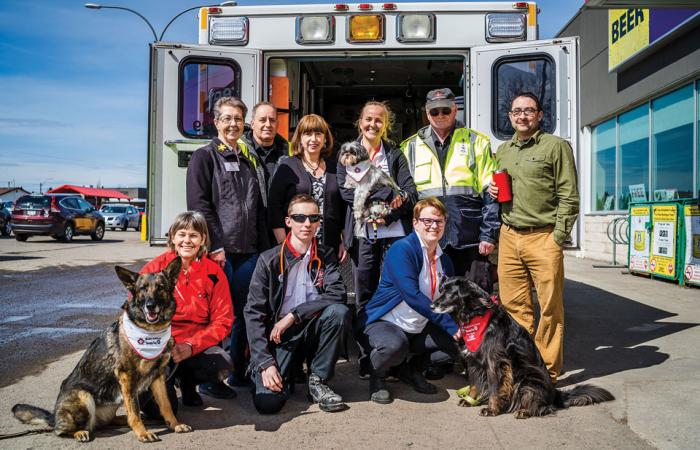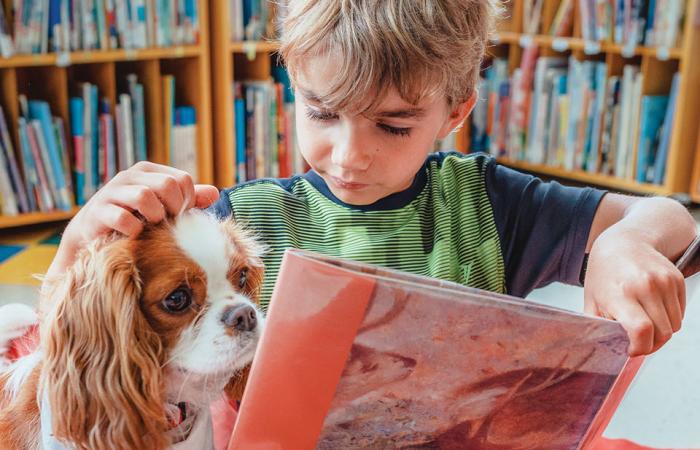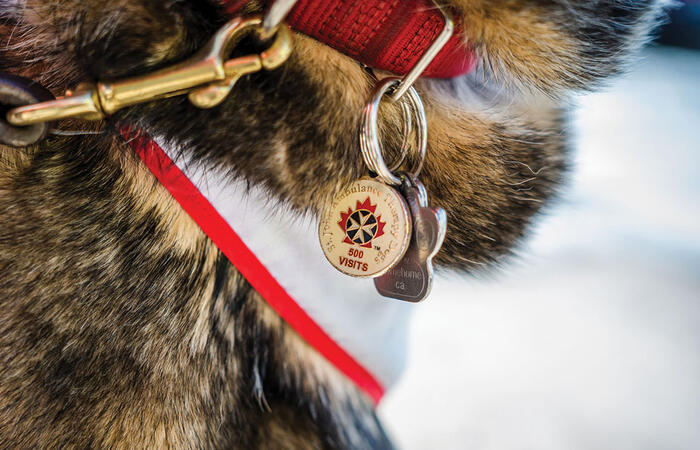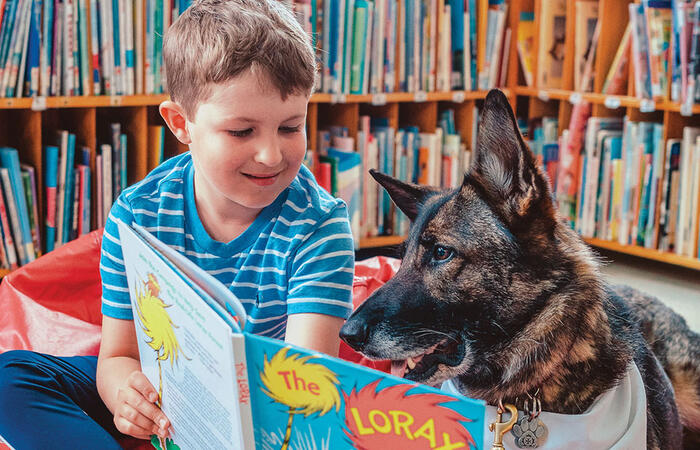“Everyone thinks they have the best dog, and none of them are wrong.”
– Unknown
Because she dreamed of God and a dog named Cap, young Florence Nightingale knew she was meant to heal. Years later, the founder of modern nursing would counsel pet therapy for all her ill or injured patients. Sigmund Freud, the founder of modern psychology, regularly brought his Chow Chow, Jofi, into sessions with him, noting how quickly both he and his patient relaxed when the dog was around. There’s just something about a dog.
Jill Biggs is the coordinator of the Thunder Bay branch of the St. John Ambulance Therapy Dog Program. The program started in 1992 in Peterborough, Ontario, and spread across Canada faster than a dog can wag its tail. In 2001, the program launched here in Thunder Bay, and quickly found an ever-expanding role in the community.
“So many organizations benefit from the presence of a therapy dog,” says Biggs, her German Shepherd, Flynn, lying adoringly at her side. “And we bring our dogs anywhere there might be stress or anxiety. Nursing homes, long-term care homes, hospitals, and the youth correctional centre, to name a few. We are regulars at St. Joseph’s Care Group and the Thunder Bay International Airport. We’ve been invited many times to Lakehead University and Confederation College, especially during mid terms and exams, because sometimes a student is missing their pet back home, and just needs the reassurance of a dog.”
“Petting, scratching, and cuddling a dog could be as soothing to the mind and heart as deep meditation, and almost as good for the soul as prayer.”
– Dean Koontz
But there is more to this phenomenon than just the smiling eyes and wagging tail, because science backs up what Nightingale and Freud instinctively knew. Endorphins are released in the human brain when petting a calm, responsive animal, and the hormones oxytocin, prolactin, serotonin and dopamine have been recorded as increasing a patient’s sense of wellbeing. Increased endorphins and decreased catecholamines result in a substantial reduction in the perception of pain, and blood pressure lowers to the point of relaxation and calm. Clearly, this is an area where medical practice and common sense meet, and dogs are excellent arbitrators in times of conflict and stress.
“When the dog looks at you, the dog is not thinking what kind of a person you are. The dog is not judging you.” – Eckhart Tolle
“Dogs don’t judge,” says Biggs. “They don’t care if you have no money, or if you’re afraid of airports, or if you have autism, or if you can’t read. They just care about you. We have a program called Paws for Stories, where the dogs go into elementary schools to sit with kids who don’t want to read in front of the teacher or the class. But they will sit with a dog and ‘teach her to read’ without fear of judgment, because the dog just thinks they’re awesome.”
The current canine program has a core team of 50 handlers and dogs, and they take applications for screenings twice a year. Because of the sensitive situations that the teams find themselves in, testing is rigorous and thorough, and even more so if the dog/handler team is hoping to work with children. All dogs must have a good obedience record, able to walk calmly on loose leash with no pulling, lunging, barking, or jumping up. They must be good with other dogs (in case they meet one during a visit), and they must demonstrate the ability to sit/stand/stay calmly for long periods of time.
I look down at Flynn, who’s been lying at her mom’s side during the entire interview. She’s a German Shepherd, fabled for obedience, intelligence and protection. It’s not a breed I would have associated with a therapeutic role, and I ask Biggs about that.
“There’s no breed preference,” says Biggs. “It’s all in the temperament. Yes, they need basic obedience – sit, stay, heel, etc, but each dog is so different. We have big dogs, little dogs, purebreds and mixed breeds. Our biggest is Derby, who is a Newfie cross. It all comes down to temperament. Most of all, they must love people.”
To showcase some of the dogs in action, Biggs and team are wrapping up production on the 2020 Therapy Dog calendar, which should launch later this month at ThunderCon. As the organization’s designated charity and with this year’s theme of Heroes and Villains, it’s clear that the St. John Ambulance Therapy Dogs are the real heroes.
Flynn agrees, and rolls onto her back for a tummy rub. I happily oblige, telling her she’s the good girl, the best girl. Biggs beams.
“We all have the best dog,” she says.
A truer thing was never spoken.
For more information on the St. John Ambulance Therapy Dog Program, you can check out their website at www.sja.ca, or on Facebook. Or email Jill Biggs and Flynn at mfrbiggs@gmail.com.









